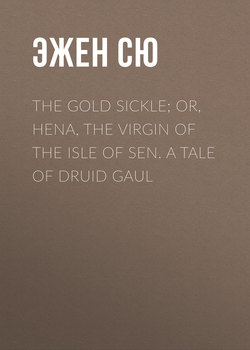Читать книгу The Gold Sickle; Or, Hena, The Virgin of The Isle of Sen. A Tale of Druid Gaul - Эжен Сю - Страница 1
TRANSLATOR'S PREFACE
ОглавлениеThe Gold Sickle; or, Hena the Virgin of the Isle of Sen, is the initial story of the series that Eugene Sue wrote under the collective title of The Mysteries of the People; or, History of a Proletarian Family Across the Ages.
The scheme of this great work of Sue's was stupendously ambitious – and the author did not fall below the ideal that he pursued. His was the purpose of producing a comprehensive "universal history," dating from the beginning of the present era down to his own days. But the history that he proposed to sketch was not to be a work for closet study. It was to be a companion in the stream of actual, every-day life and struggle, with an eye especially to the successive struggles of the successively ruled with the successively ruling classes. In the execution of his design, Sue conceived a plan that was as brilliant as it was poetic – withal profoundly philosophic. One family, the descendants of a Gallic chief named Joel, typifies the oppressed; one family, the descendants of a Frankish chief and conqueror named Neroweg, typifies the oppressor; and across and adown the ages, the successive struggles between oppressors and oppressed – the history of civilization – is thus represented in a majestic allegory. In the execution of this superb plan a thread was necessary to connect the several epochs with one another, to preserve the continuity requisite for historic accuracy, and, above all, to give unity and point to the silent lesson taught by the unfolding drama. Sue solved the problem by an ingenious scheme – a series of stories, supposedly written from age to age, sometimes at shorter, other times at longer intervals, by the descendants of the ancestral type of the oppressed, narrating their special experience and handing the supplemented chronicle down to their successors from generation to generation, always accompanied with some emblematic relic, that constitutes the first name of each story. The series, accordingly, though a work presented in the garb of "fiction," is the best universal history extant: Better than any work, avowedly on history, it graphically traces the special features of class-rule as they have succeeded one another from epoch to epoch, together with the special character of the struggle between the contending classes. The "Law," "Order," "Patriotism," "Religion," "Family," etc., etc., that each successive tyrant class, despite its change of form, fraudulently sought refuge in to justify its criminal existence whenever threatened; the varying economic causes of the oppression of the toilers; the mistakes incurred by these in their struggles for redress; the varying fortunes of the conflict; – all these social dramas are therein reproduced in a majestic series of "novels" covering leading and successive episodes in the history of the race – an inestimable gift, above all to our own generation, above all to the American working class, the short history of whose country deprives it of historic back-ground.
It is not until the fifth story is reached – the period of the Frankish conquest of Gaul, 486 of the present era – that the two distinct streams of the typical oppressed and typical oppressor meet. But the four preceding ones are necessary, and preparatory for the main drama, that starts with the fifth story and that, although carried down to the revolution of 1848 which overthrew Louis Philippe in France, reaches its grand climax in The Sword of Honor; or, The Foundation of the French Republic, that is, the French Revolution. These stories are nineteen in number, and their chronological order is the following:
Long and effectually has the influence of the usurping class in the English-speaking world succeeded in keeping this brilliant torch that Eugene Sue lighted, from casting its rays across the path of the English-speaking peoples. Several English translations were attempted before this, in England and this country, some fifty years ago. They were all fractional: they are all out of print now: most of them are not to be found even in public libraries of either England or America, not a wrack being left to them, little more than a faint tradition. Only two of the translations are not wholly obliterated. One of them was published by Trübner & Co. jointly with David Nutt, both of London, in 1863; the other was published by Clark, 448 Broome street, New York, in 1867. The former was anonymous, the translator's identity being indicated only with the initials "K. R. H. M." It contains only eight of the nineteen stories of the original, and even these are avowedly abridgments. The latter was translated by Mary L. Booth, and it broke off before well under way – extinguished as if snuffed off by a gale. Even these two luckier fragmentary translations, now surviving only as curios in a few libraries, attest the vehemence and concertedness of the effort to suppress this great gift of Sue's intellect to the human race. It will be thus no longer. The Mysteries of the People; or, History of a Proletarian Family Across the Ages will henceforth enlighten the English-speaking toiling masses as well.
DANIEL DE LEON.
New York, May 1, 1904.
